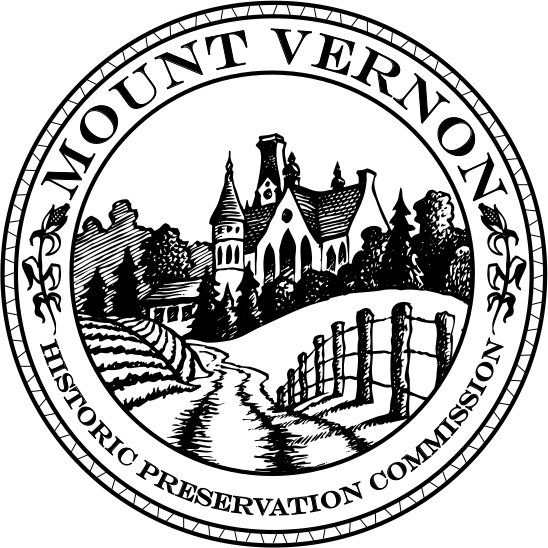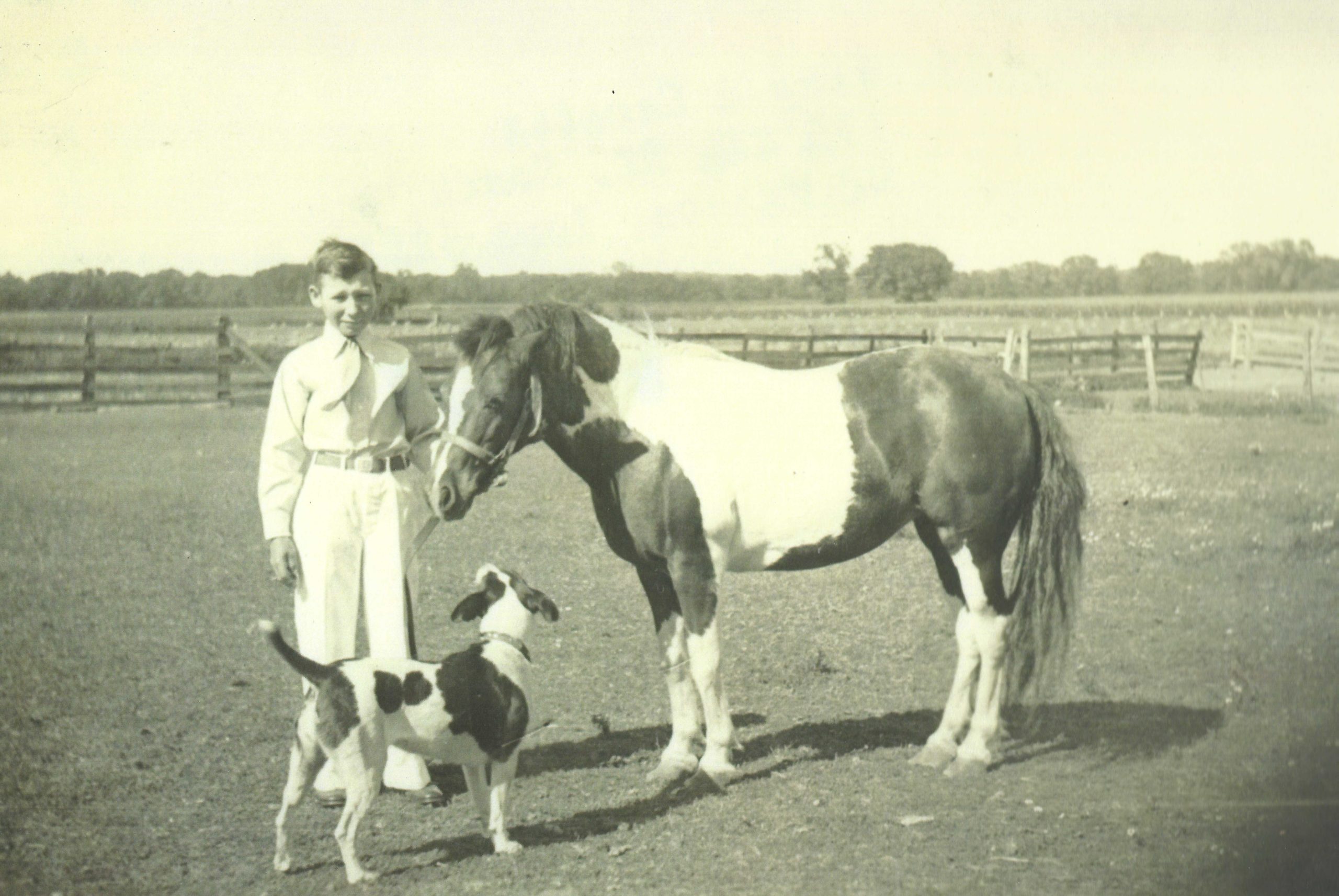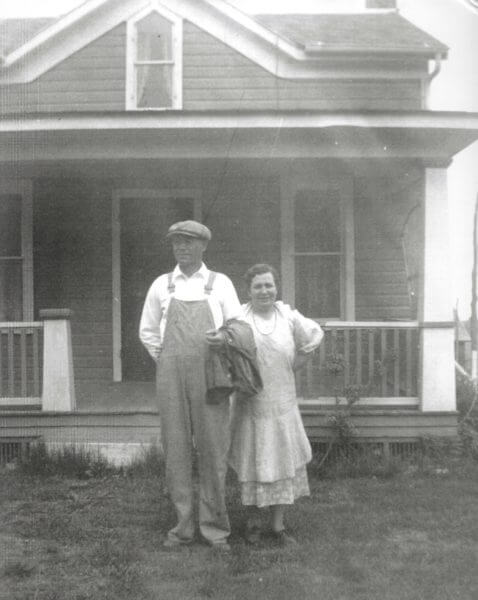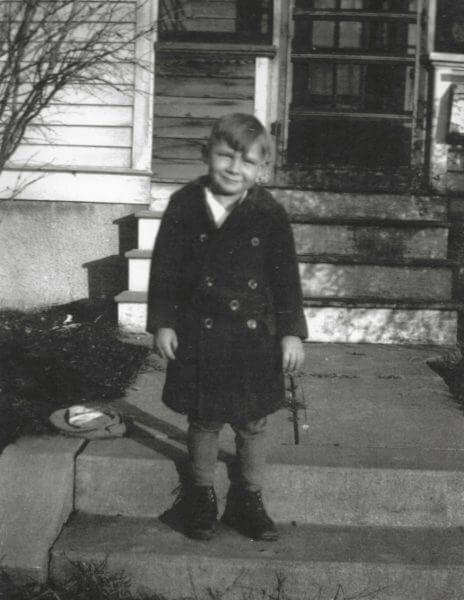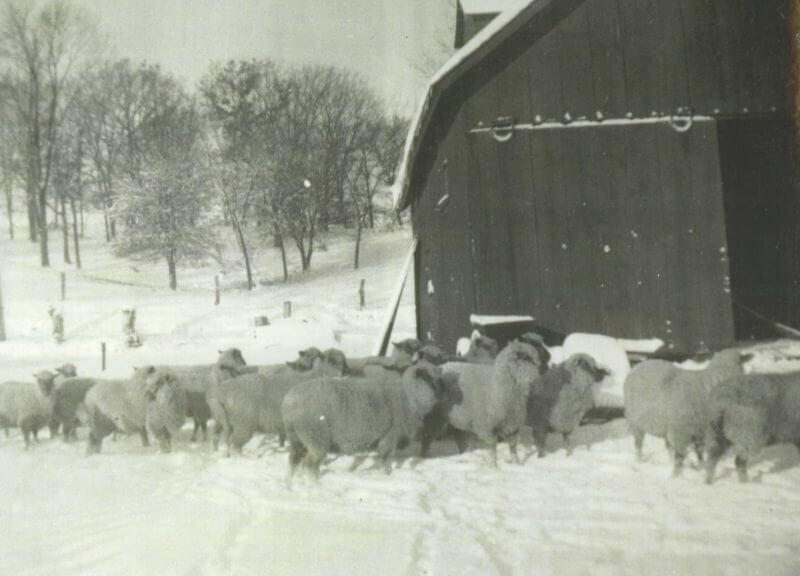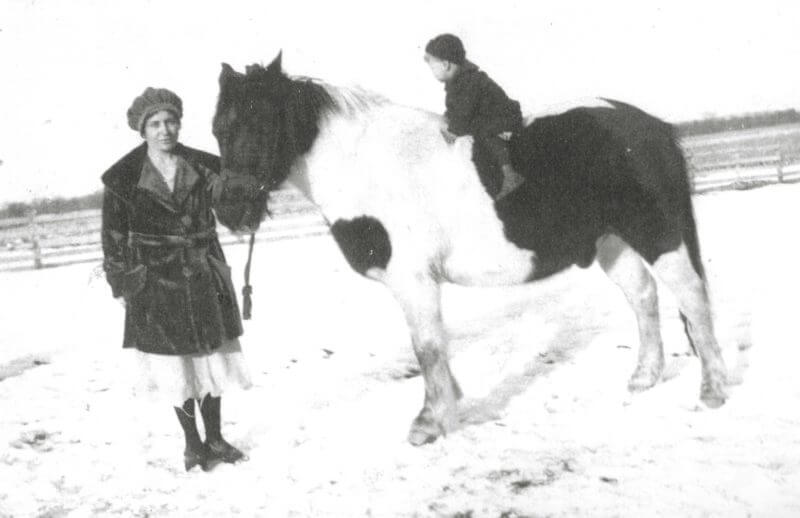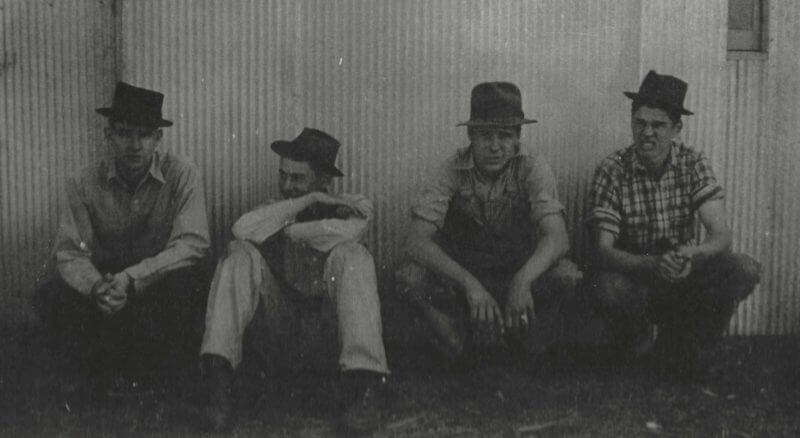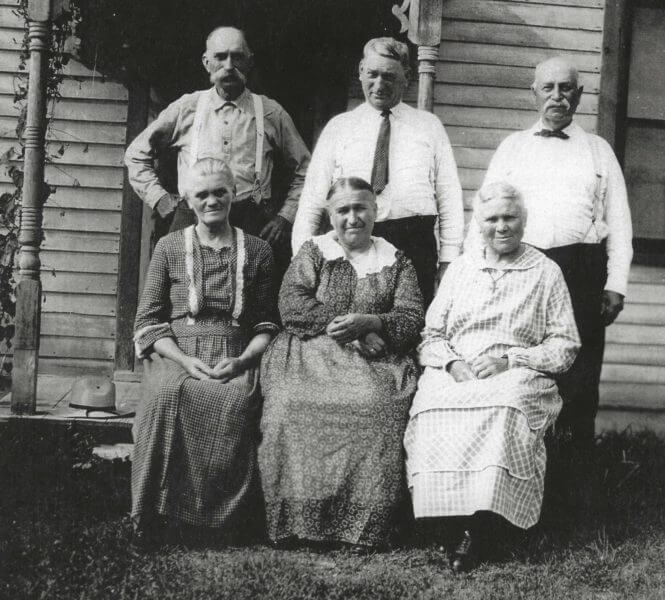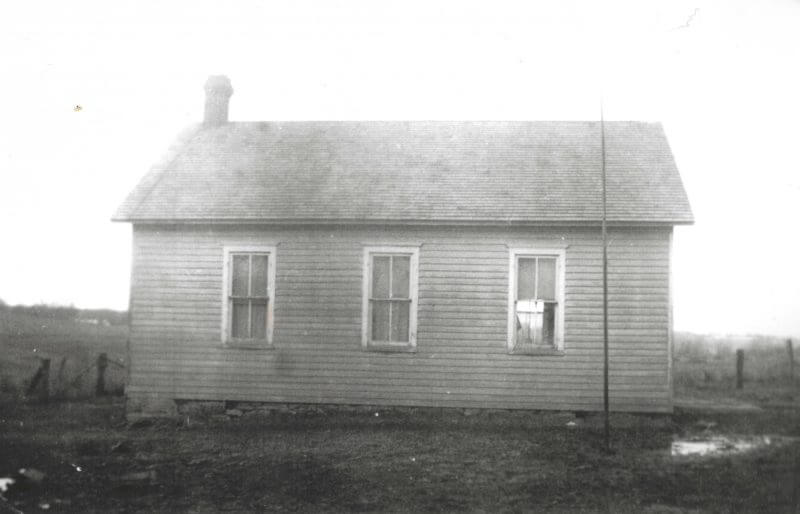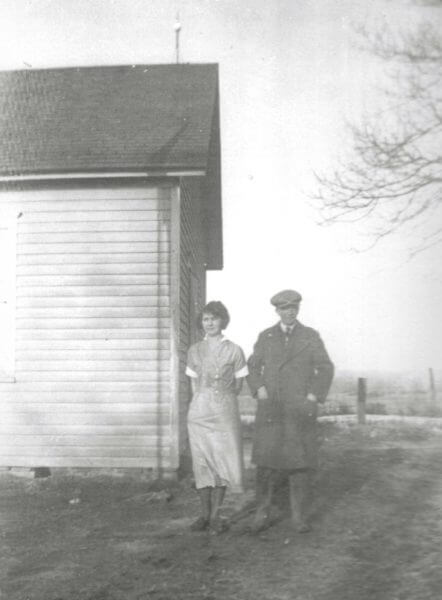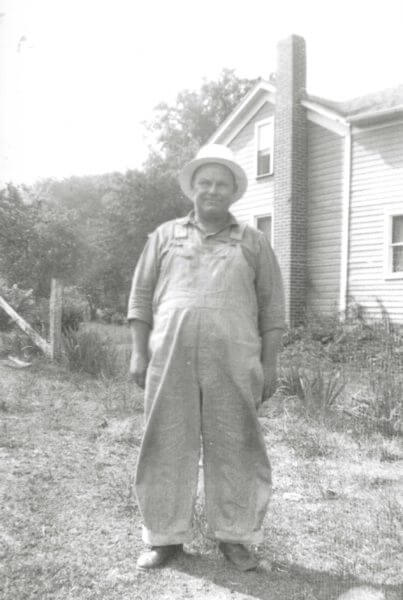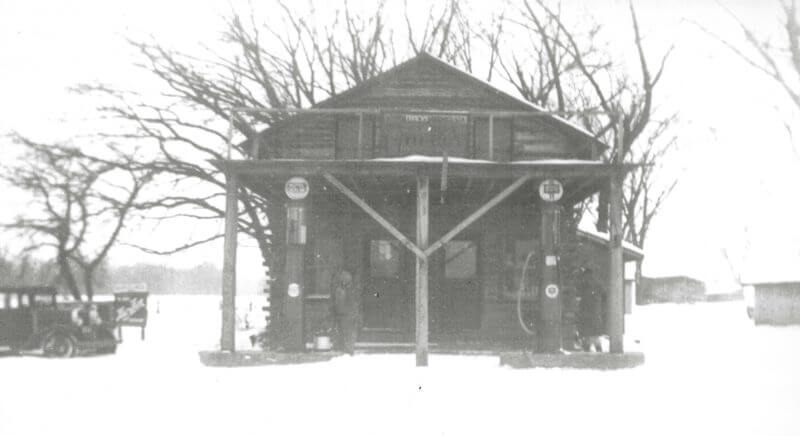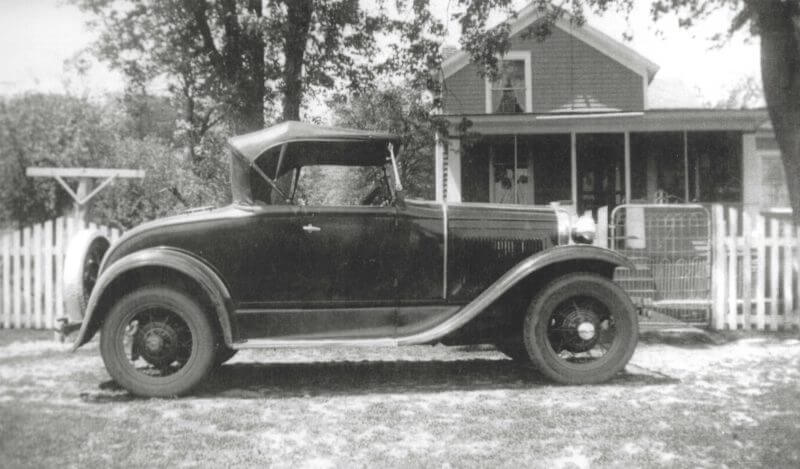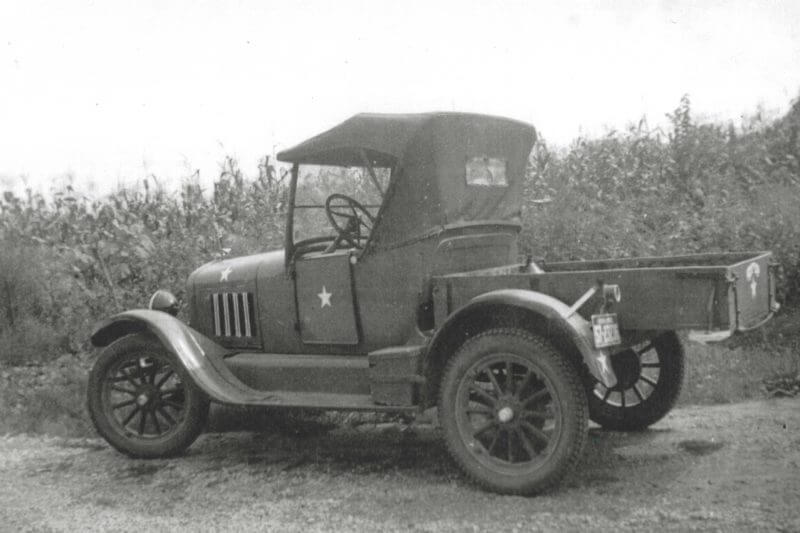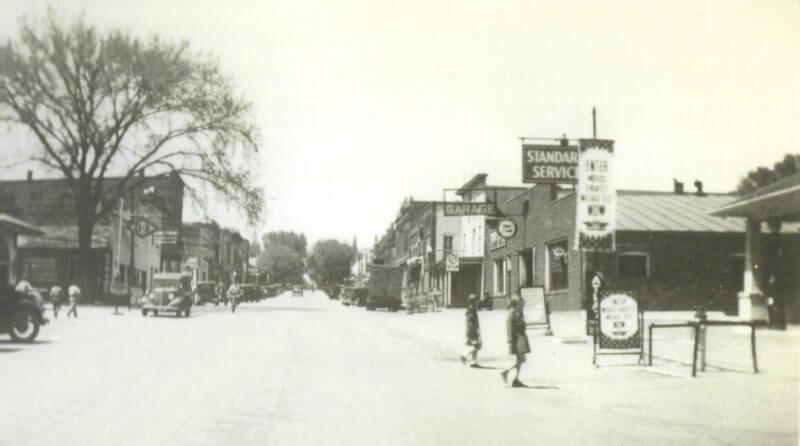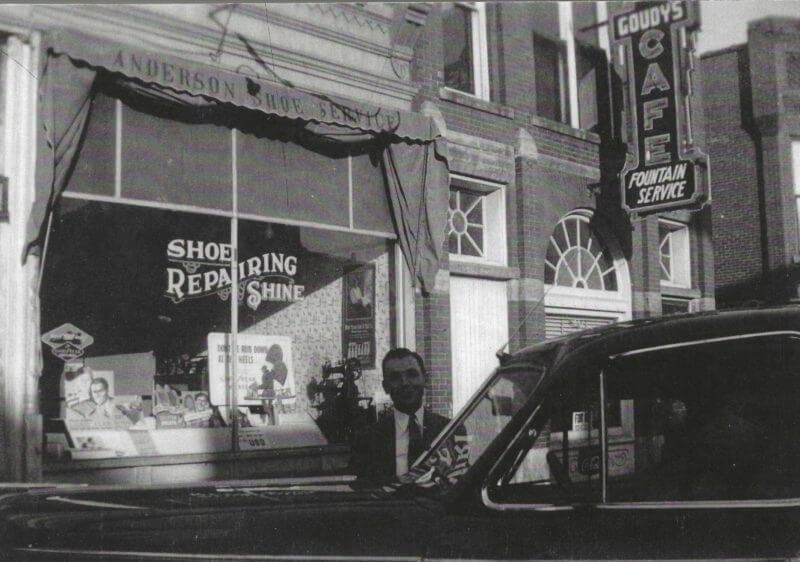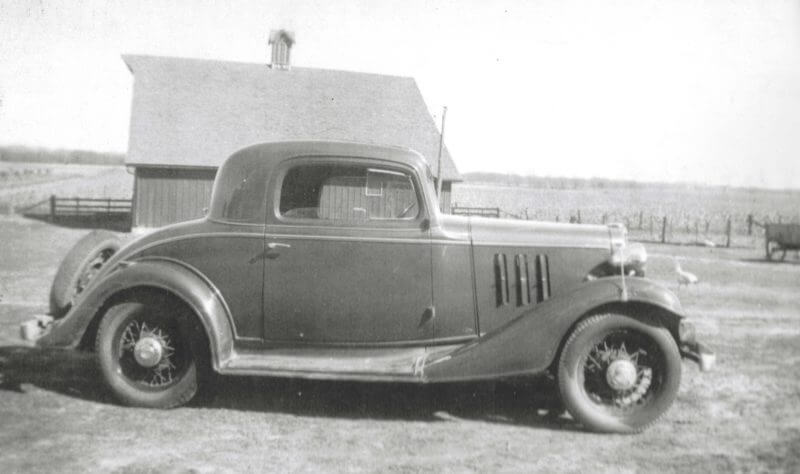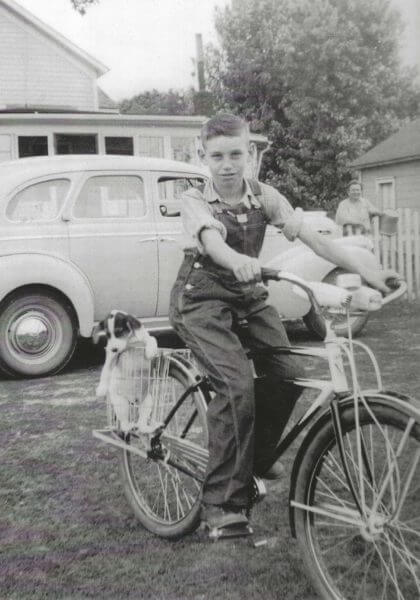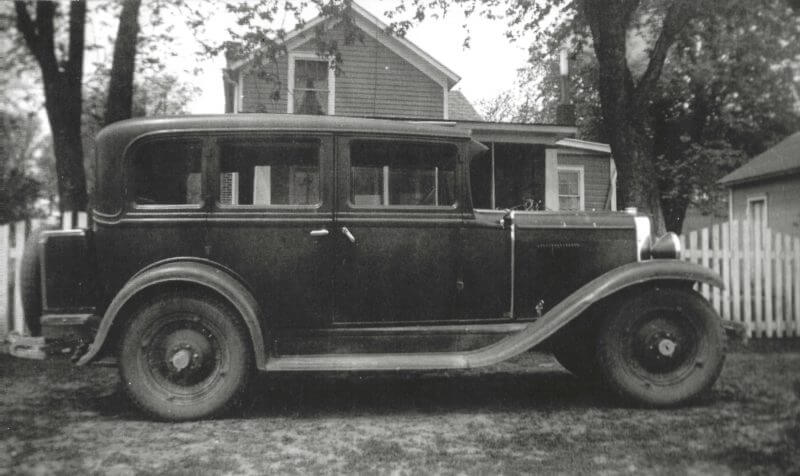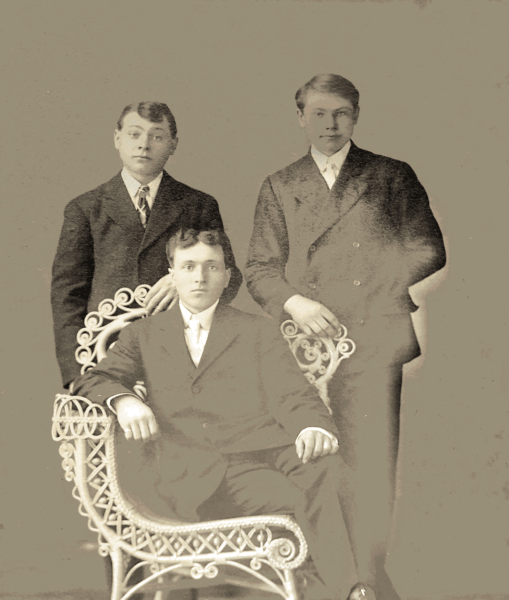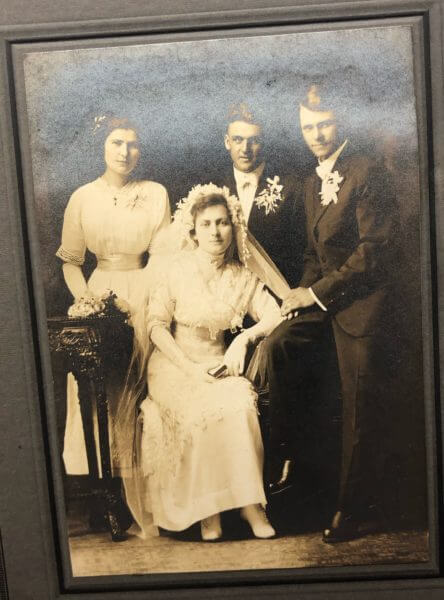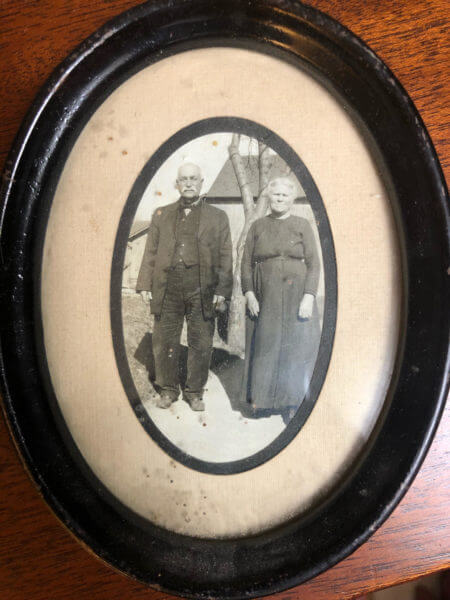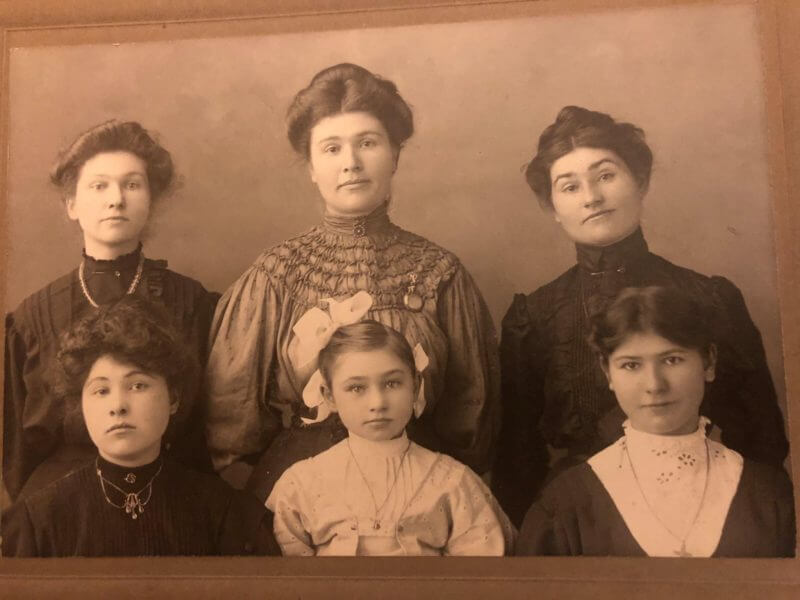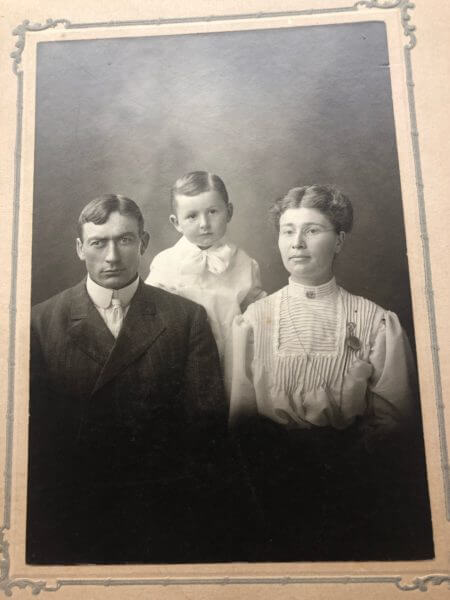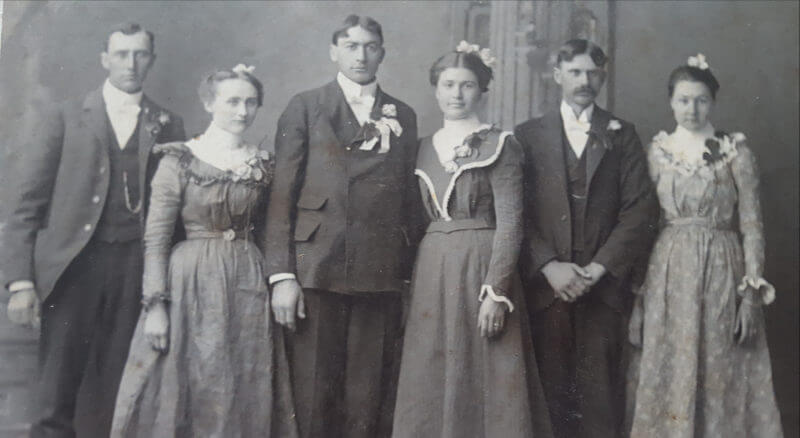Prepared and donated by Carolyn Wellso, 2004
Adapted for web in 2021
Virgil Crofter (1921-2012) was a life-long resident of the Mount Vernon/Ivanhoe/Iowa City/Cedar Rapids area including the South Cedar portion of the county. His family has deep roots in the Bohemian community along the Red Cedar River. His autobiography and photographs make up the “Crofter Collection”.
Carolyn Wellso realized the value of his photo collection and autobiography as documentation of a portion of rural life and Czech heritage along the Red Cedar River, and the interplay between towns and rural life.
Virgil Crofter’s autobiography and photos can be retrieved by entering “Crofter” in the search section of the Mount Vernon Historic Preservation Commission website.
In the Words of Virgil Crofter
115 4th Street SW, Mount Vernon, IA
My grandfather Thomas Crofter originated from Cedar Bluffs, Cedar County. He was born in Bohemia and came to this country in 1856 when he was four years old.
When my grandfather came to Linn County, he bought a farm on the southside of the Cedar River in the Ivanhoe settlement east of the river. By the early 1900s the first settlers had moved on and the neighborhood was filling with Bohemian families, many of them were related to each other. Transportation was difficult so people more often than not found someone to marry who lived nearby.
The Vincent James Pisarik family had Riverside Farm on the bend of the river opposite the old Indian fording spot. We were related to the Pisariks by marriage. My grandfather Thomas Crofter had Pleasant Valley Farm, south of the Pisarik farm. My grandfather’s brother, James Crofter, had a farm that bordered the river west of Cedar Island.
The Joseph Sedlaceks, his wife was my aunt, had the farm touching on the Crofter land. South of the Sedlacek’s land on the west bank of the river was Joseph Pavelka’s land. His son Dwayne Pavelka still owned the land in 2001. The Dvoraks and other Czech families had land on the north and south of the bend in the Cedar River near Ivanhoe.
On Sunday, the families that were related made the rounds visiting each other, you went to their house or they went to your house. You would gather in the yard and chat. Usually, you had a chicken dinner on Sunday. Rest of the time we ate pork.
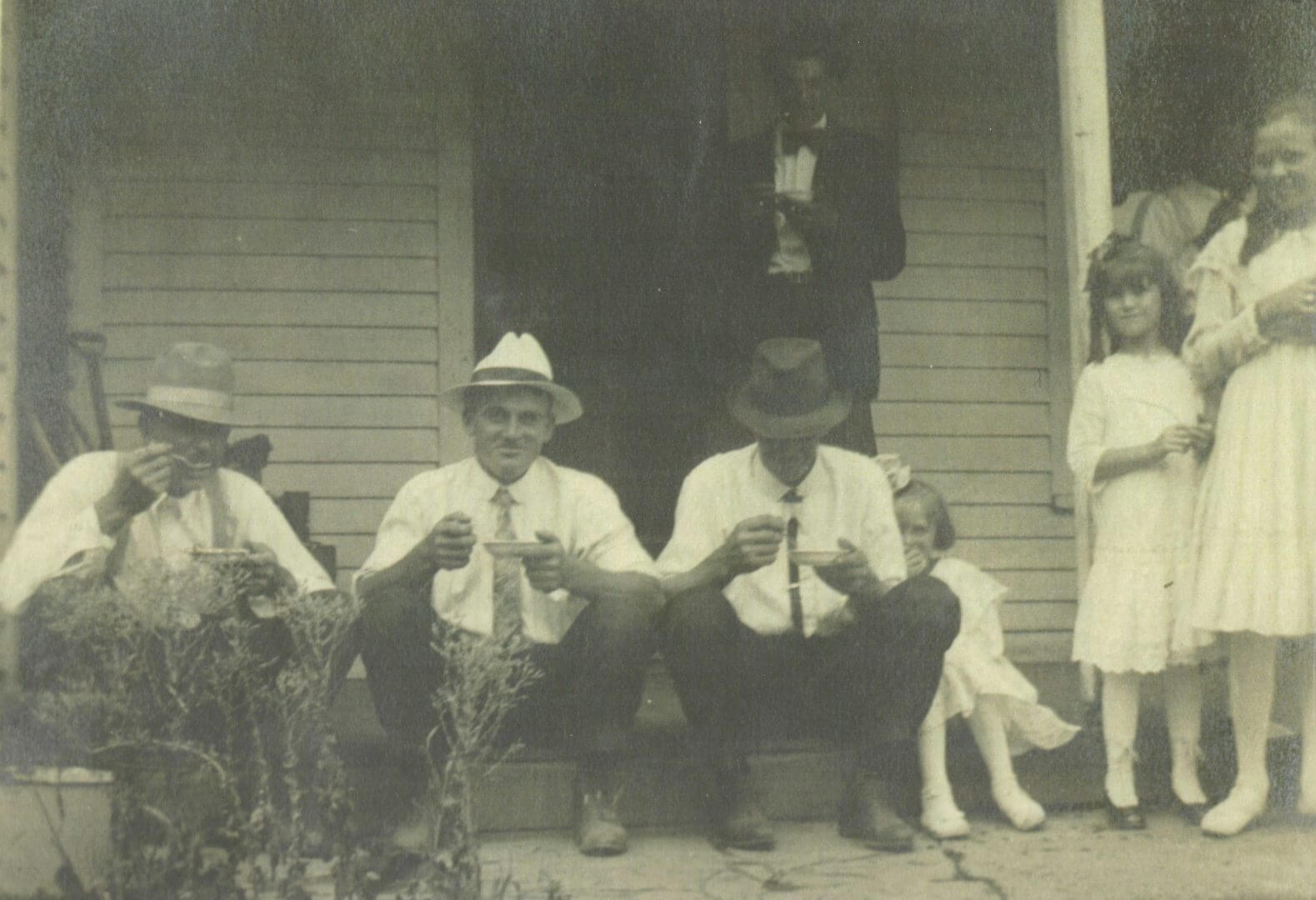
My grandfather, Thomas Crofter’s farm, which in time became my father’s farm was located off Ivanhoe Road on the road that ran to the Cedar River where is now a park named South Cedar Access. It was said, that on the top of the hill in a piece of timber west of the road were old Indian burial areas. This area of the river on both sides was the home to Indian campsites. The J. Kirkpatricks had homesteaded the area, and there were the Kirpatrick graves still on our farm, which were later fenced off.
My father was Wesley Crofter, and he was born at Pleasant Valley Farm on November 30, 1890. My mother, Blanche Haman Crofter, was born on September 23, 1891 and was brought up on a farm south of Tiffin. My mother’s sister married John T. Pisarik. My mother’s parents were Vincent and Mary Haman.
I was born on February 16, 1921. When my parents were married and before my birth, they lived on the farm but later decided to move to Cedar Rapids. I was born in a house on 16th Avenue SW in the Czech Village where the bandstand is now located. Dad had a farm sale before we moved to Cedar Rapids, and Bummie Reyhons was renting the farm.
In a year or two my parents moved to Iowa City. We lived on South Summit Street and Dad worked at an automobile garage for $17.00 a week. He worked six days and every other Sunday. He had fun at work and saved enough to buy a house. We had a good time but in 1928 my father decided to move back to the Pleasant Valley Farm. Dad had to go around to sales to get things for the farm and start over again.
Ivanhoe Farm Days
There were still two old log cabins on my Dad’s farm when we came back to it. There was a log cabin that the Kirkpatricks had homesteaded in the rear of the house and another log cabin used as a corncrib. A frame house had been built on the farm in the early days. There was a nice barn and outbuildings.
Dad had a ninety-five-acre farm. Dad mad money on that, not today, unless you farm thousands of acres. We all had small farms.
We were on the farm during the Depression years. We didn’t have to buy anything at the store but flour, salt, and sugar. We canned everything, butchered meat, raised potatoes and had milk from our own cows. We raised vegetables, cabbage, onions, potatoes, carrots, peas. We had a good garden.
We had sheep, always twenty to twenty-five sheep. They mowed the lawn; we never mowed the lawn. They kept the ground clear in the woods. We raised pigs and rendered the meat, cooking it and putting it in lard covered jars.
Mom had a chicken house and chickens, and sometimes we had ducks. Ducks were the best eating; they are really good eating — roast duck and dressing! We had apple, plum and fruit trees. We didn’t worry about starving. We went to the woods to chop wood for the wood-burning cook stove and wood to heat the house. We had a well not too far away. We pumped out water.
We didn’t have any electricity until Dad bought a 32-volt light plant, then we had light in 1932 or ’33. Now we had a refrigerator, before we had to use the basement, which was always nice and cool. Dad liked to be modern; we were one of the first families in the area to get the light plant. Dad had lived in town (Cedar Rapids and Iowa City) a number of years and got used to modern things.
Dad made wine, all Bohemians drank that, I know, but there were no drunkards because all Bohemians worked. The neighbors used to come over and play cards and Dad would give them homemade rhubarb wine from the basement.
We had one of the first radios. If there was anything new, we had it. Men and women came over and we had fun. The prizefights on the radio which the old fellows loved. This was before the time Joe Lewis and Jack Dempsey were fighting. The men liked boxing and not baseball.
Mom was a good cook. They were all good cooks. She made dumplings, baked oatmeal cookies and cakes. We probably had a pie almost every day.
On Sunday we attended the church of the Bohemian settlers in our area, Sts. Peter and Paul, south of our town. Raphael Pisarik can tell you the history of all that.
My School Days
I was wearing city clothes when I came back to attend Pleasant Hill Country school. It was a newly built white frame country school, and my parents must have wanted me to come back to the farm to go there. We had eleven students. The school was paid for by the tax money. The neighborhood fathers ran the school and hired the teachers. Everyone chipped into supply the firewood.
We had a nice young teacher, Martha Bartosh. During good weather, in the spring and fall the teacher walked from her home on the northeast end of Mount Vernon near the sand plant on Highway 1, which was then a rocky road. She walked the seven miles each day to and from school. It was nothing to walk to the southside of the Cedar River from Mount Vernon. In the winter she lived with her Dvorak uncle and aunt who lived nearby to the school. In later years she got a car and drove. She married a Becicka.
The country school just went to the eighth grade and after that we went to town. All country children drove automobiles. We got a license to drive when we were thirteen years old. Most the mothers did not drive, but the boys and girls could. There was a gas station on the southeast corner of the Ivanhoe Bridge. Herman Piper had built it and the Pipers had a sawmill. Later a fellow from Cedar Rapids, Art Myers, ran the gas pump and the general store that sold groceries. Gas was 17 cents a gallon, and I drove all week on one dollar of gas.
The high school in Mount Vernon had been built in 1927. It was a very well-built school. I drove a 1930 Ford Roadster to school. It had only one seat in front. When I started to school in Mount Vernon in ninth grade, I picked up kids all the way to school. I got four kids in the front seat with me, two kids hung on the running board. There was no rumble seat on the car. Kids came from all directions walking the seven miles to town.
I was in school the winter of 1936 when there was terrible snow all winter. Our bottom road was half a mile from Highway 1. We had to scoop snow by hand all day to get our car out. At age 81, I still like to scoop snow. We didn’t know such a thing as a heart attack existed as a result of shoveling snow.
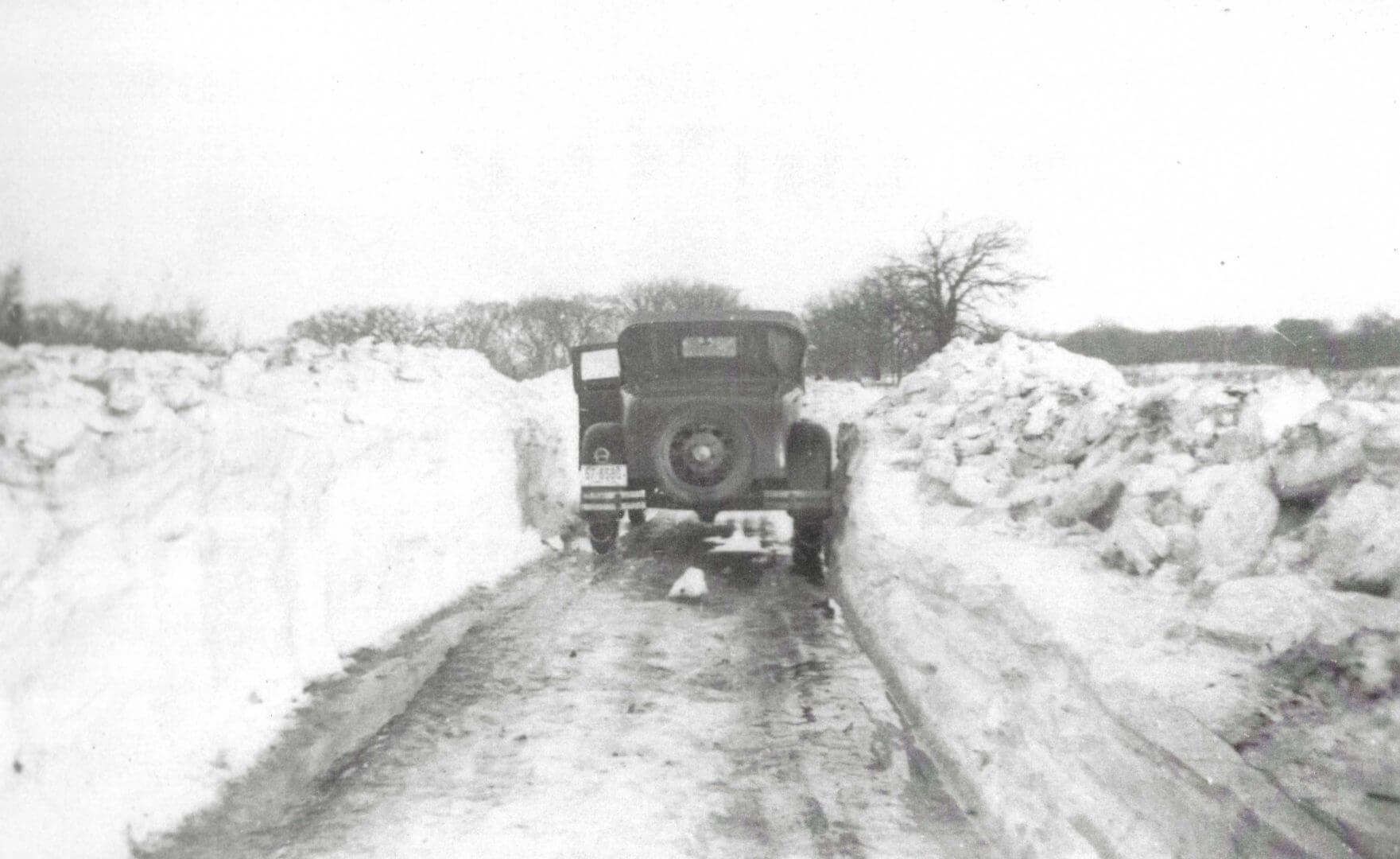
We Moved to Mount Vernon
After a time, we were on the farm, the war [World War II] was over. Dad was getting old. The farmers were moving to town, Dad had taken good care of everything, but the house was old. We had to build a new modern house in the country or move to town.
Dad decided to buy the white Victorian house at 203 1st Avenue SW in Mount Vernon. Mrs. Pringle, a real estate agent called Dad up Sunday telling him to put a bid on the house for $7,500, which was under the price asked. The owner had been in business in Mount Vernon but had moved to Oxford Junction. He was told he would get cash if he took the offer. It was consented and afterward a lot of people wished they had it. It was a nice house but seemed like a lot of money in 1947.
There was a grocery store half a block from Main Street up on the eastside of Highway 1 owned by Marvin Turner and later Jim Petrick bought the building there and ran a grocery store, too. Across from the grocery store on the westside of the street and near city park was an old two-story house which went down when parking was put back there.
I remember the light company building on the southeast corner of Main Street and Highway 1. It was three stories high and caught fire. Everything would catch fire. Afterwards the building was two stories high.
In the 1940s Saturday night was the big night, Wednesday, too. There were five grocery stores and two drug stores, we had everything in Mount Vernon, so we didn’t have to go to Cedar Rapids. We had two hardware stores. All here and Lisbon had the same way. All Main Street buildings were occupied. We had an oil station across the street to the west of the high school. We had a Standard Oil across the street, DX, another old station by the water tower. The Lincoln Highway ran through Mount Vernon and Lisbon and brought a great deal of traffic and business to the town.
Our Best Years
When we bought the house in town and for the next five years Dad and I went to the farm every day of the week. The first several years after we moved, we used to eat in the old house during the summer, as time passed, and the old farmhouse was occupied we had to tear it down. There are not may buildings left on the farm now and the barn is ready to go. We sold it to Steve Jilovec, who I watched grow up from the time he was a little boy.
Mom did not need a garden in town because we brought all the food she needed back from the farm. In town we had a rhubarb patch in back and a patch of horseradish in back of the garage. That was enough.
When we bought the house the old coal furnace had been converted to oil. At that time oil was cheap. It got to a point oil was expensive. I bought a new wood stove and we set it up. We brought in wood from the country and used it for the stove in town. The oil furnace didn’t kick on very much.
My father loved trees and flowers. After Dad sold the farm, Dad and I tore down the old automobile garage that the Wests had built. We made a new two-stall garage. Dad built the doors himself and the door opened with weights of sand. Dad planted a tree west of the garage; we lost an elm by the driveway. He made a white picket fence and planted roses. He built a trellis for the roses and one on the front porch and one by the garage.
In the summer, my parents could sit on the porch and talk. The neighbors loved to be outside in the summer and would gather together and talk. The front porch was a busy place. In the winter there was a lot of excitement on Highway 1 in front of the house. There it could look like a circus with trucks and cars trying to get up the hill, slipping back and sometime jack knifing. You can’t image what went on, on that hill.
We Get One of the First Television Sets
When we moved to the house, television was coming in. My dad liked to be first in things. He bought a cabinet television set from the Travers. The men liked to watch Saturday night wrestling. We were the only ones to have a TV in the neighborhood, and later there was a second. Chester Bolton built a new ranch house across the street. He had a TV. Our house was high and his low. He would come over and look at our reception and then go home and work on his roof with his TV antenna. There were only two TV stations, Rock Island and Davenport. Cedar Rapids didn’t have TV. Of course, it was black and white. In 1951 or ’52, people started to watch TV and not play cards at night.
South of us, two doors down were Frank and Anna (Tipinka) Wolrab. The Wolrabs, had also moved from the farm south of town when their son Milo married Mary Ellison. Frank Wolrab went to their farm everyday which was located at the crossroads of Highway 1 and the old St. Mary’s Road (now Light Road). Mike and Daisy Novak lived in the cottage on the corner of 3rd Street SW and Highway 1. They also had lived in the country.
Mrs. Meakin lived to the south of us in a very old house. To the northwest of us on 2nd Street SW, where the post office is now, was a vacant lot with a barn, just over our lot line which the Petricks owned at the time. The Gaines were going to build a home on the lot but got as far as digging the basement and living in it, and no further. When the post office bought the lot, Leroy Heady and I made a deal with the post office and we tore the old barn down. Leroy and I divided the concrete blocks and wood. We had fun taking the barn down. I took the wood back to the farm. It was useful for repairs to our barn.
The cottage around on the southside of the post office was somewhat wooded. Lee and Edna Evans lived there. There was kind of a spring and creek in back of our house and the house to the south of us. I remember when I was in high school the Wolfe ladies who had been teacher lived in our home (1914-1938). One day there was a fire in the house attic and all the school kids came down from the high school to watch the fire. A new roof had to be put on the house after the fire.
Year later, Dad decided to put on a second roof on the house. He was over seventy, but he did it and carried all the shingles up the ladder himself. The neighbors across the street couldn’t watch. Dad was used to working. He didn’t know any other way.
Cars and Trucks
I had a new 1947 Oldsmobile when we bought the home. In time I got a truck. Every two or three years I would trade cars. There was an automobile garage in town that sold cars and we had an arrangement with them. I liked cars very much. I wish I still had some of the cars. I bought a two-ton truck and started trucking as well as farming, hauling cattle and grain for the neighbors for twenty-five years.
My Parents Died
My mom died in 1974 when she and Dad were both 83. I was 54. She just got weaker and weaker and died. After Mom died Dad hated to move. Now he cooked and made the bed and cleaned the house. He never worried about anything. He was happy when he got in his nineties. I worried about him on the stairs. I bought a new one-story brick home in 1982 at115 4th Street SW. He moved with me and one year later was in the nursing home. He made his bed in the nursing home. He was used to it.
We sold the house at 203 1st Avenue SW to Bob Wolfe for $26,000 and he sold it to Cindy Baker for $32,000 for a group antique shop. Dad was 95 and I was 66. Bob Wolfe is the nephew of Grace Wolfe, who had owned our house for so many years.
Dad was 99 when he died. Dad’s sister was 102.
People don’t enjoy themselves now as they did. They have too much. Dad was from a family of ten, Mom a family of eleven. I have a cousin in his 80s, Sam Sedlacek, who still works as a custodian in Cedar Rapids at a school.
I remember when I went to high school and the Cedar River came up. Raphael Pisarik and I would have to walk the hills to avoid the flooded roads along the Cedar River and to get to Highway 1 to go to school in Mount Vernon. When it rained, we needed chains because of the mud roads and I drove to the garage where the Mount Vernon Pharmacy is and they put on the chains.
In the last fifty years I have had oatmeal every day, in the morning. I eat carrots every single day. I am 81 and I can pass the drivers test without glasses. The examiner made me take the test three times because she couldn’t believe it. I don’t take any medicines. I told other people to eat carrots.
Barbara Gordon Leach donated the following photos to the Crofter Collection.
In the words of Barbara Gordon.
Virgil Crofter was my mother’s first cousin. His father Wesley, was my grandmother Barbara Crofter Hynek’s sister. We have been to visit Cedar Rapids, Mount Vernon and Tama in the last ten years. We tried to locate where the farm was but drove around in circles.
We are familiar with many of the names on the neighboring farms in a map I located, as the sisters married into, just as Virgil said, and found it interesting that he was the grandchild who grew up on the farm. The map I located was from the late 1880s of the Franklin Township showing all the farms and the family names who lived there. I was delighted to find the Crofter farm-and see the name “Pleasant Valley farm” under his name on the map.
Our grandmother did not marry into a neighboring farm family. She moved to Cedar Rapids as a young woman and lived with one of her older married sisters. She met and married John Hynek, a newspaper man. They lived in the Czech village with his widowed mother until moving to Tama to run the newspaper and raise their family, which included my mother.
